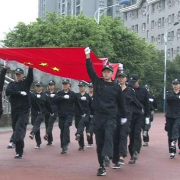引进英文?英文翻译
来源:择校网 时间:2025-03-02 03:00:42
一、英文翻译***导入***引入
导入英文:leading-in
引入英文:import
词汇解析
1、lead
英 [li:d;led];美[lid; lɛd]
n.领导;铅;导线;榜样
vt.领导;致使;引导;指挥
vi.领导;导致;用水砣测深
adj.带头的;最重要的
n.(Lead)人名;(英)利德
例:The president and vice president led the mourners.
总统和副总统带领着送葬人群。
例:He walks with a stick but still leads his soldiers into battle.
尽管他拄着拐杖,但他仍带领士兵上战场。
2、import
英[ɪm'pɔːt;'ɪm-];美['ɪmpɔt]
n.引入,进口,进口货;意思,含义;重要性
vt.输入,进口;含…的意思
vi.输入,进口
例:Rich countries benefited from importing Indonesia's timber.
富国从进口印度尼西亚木材中获利。
例:To import from Russia, a Ukrainian firm needs Russian roubles.
要从俄罗斯进口,乌克兰公司需要俄罗斯卢布。
扩展资料
lead的用法
1、lead的基本意思是“站在别人前头,拉着手加以引导”,强调以领导者身份走在前头,带领别人秩序井然地前进,常含有“指挥、控制”的意味。lead引申可表示“致使,诱导”。
2、lead可用作及物动词,也可用作不及物动词。用作及物动词时,后可接名词、代词作宾语,也可接双宾语。
3、lead作“引导”解时往往跟to引起的介词短语作状语或宾语补足语;作“领导”解时可接“in v-ing”;lead作“使得”解时可接带to的动词不定式充当补足语的复合宾语。
4、lead用作名词作“领导,榜样”解时常与不定冠词a连用;作“首位,领先”解时,常与定冠词the连用;作“线索”解时,常用复数形式。
5、lead做动词使用,可以解释为“引导”,“领导”,如lead him there或者lead somebody to his home。
6、短语lead to,解释为“导致”。
二、导入的英文
导入的英文单词有两个,分别是introduction和lead。
introduction的英式读法是[ˌɪntrə'dʌkʃn];美式读法是[ˌɪntrə'dʌkʃn]。作名词意思是介绍;引进;序言;导论。
lead的英式读法是[liːd];美式读法是[liːd]。作动词时意思是引导;领先;带领;过...(的生活);导致。作名词时意思是领头位置;主角;榜样;引言;铅。
相关例句:
1、She led the way downstairs for us.
她引着我们下楼。
2、He gave us a brief introduction about his company.
他向我们简要地介绍了一下他的公司。
扩展资料:
单词解析:
一、introduction
词义辨析:
n.(名词)
1)introduction, foreword, preface
introduction意为“引言”,用得比较多,有时作为专著,或教科书的第一部分,它又可分为若干章节。
foreword意为“前言”,多指一部作品的短序,内容不一定和作品有关。
preface意为“序言”,可以由作者自序,也可由他人作序,内容不受限制,比foreword长。
2)introduction,preface
这两个名词均有“前言、导言”之意。
introduction普通用词,指任何作品开头对读者或听众说明或介绍该作品,起引导作用的结论部分,和全书内容是一致的。
preface指作者或编者为说明全书的目的、范围、编辑方法等在序言之前写的一段简短的序文。
二、lead
用法:
v.(动词)
1)lead的基本意思是“站在别人前头,拉着手加以引导”,强调以领导者身份走在前头,带领别人秩序井然地前进,常含有“指挥、控制”的意味。lead引申可表示“致使,诱导”。
2)lead可用作及物动词,也可用作不及物动词。用作及物动词时,后可接名词、代词作宾语,也可接双宾语。
3)lead作“引导”解时往往跟to引起的介词短语作状语或宾语补足语;作“领导”解时可接“in v-ing”;lead作“使得”解时可接带to的动词不定式充当补足语的复合宾语。
n.(名词)
lead用作名词作“领导,榜样”解时常与不定冠词a连用;作“首位,领先”解时,常与定冠词the连用;作“线索”解时,常用复数形式。
参考资料:
百度百科-lead
三、有哪些英文单词是由别国语言引进的
英语相当多的词语都是外来词,其中以拉丁语,法语之类的最多
这个网站里有全部外来语的归纳
从中国引入的词语
B
Bok choy
(Cantonese)白菜(baakchoi), a Chinese cabbage: literally'white vegetable'
C
Char
colloqiual English word for'tea', originally from Chinese茶(Mandarin chá).
Cheongsam
from Cantonese长衫(cheungsaam), lit. long clothes.
China
via Latin from the name of the Ch'in Dynasty秦
Chop chop
from Cantonese gup急, lit. hurry, urgent
Chopstick
chop is from the Cantonese夹(gaap), literally'to squeeze'. Notice the two man radicals(人) sandwich another man radical in the middle.
Chop suey
from Cantonese杂碎(tzapseui), lit. mixed pieces
Chow
from Chinese Pidgin English chowchow which means food, perhaps based on Cantonese炒, lit. stir fry(cooking)
Chow chow
any of a breed of heavy-coated blocky dogs of Chinese origin
Chow mein
from Cantonese炒面(chaumin), lit. stir fried noodle
Confucianism
from Confucius, Latinized form of孔夫子(kǒng fūzǐ)'Master Kong'
Coolie
questionably Chinese苦力, lit. suffering labor. Some dictionaries say the word came from Hindi kull.
Cumshaw
from Amoy感谢, feeling gratitude
D
Dim sum and Dim sim
from Cantonese点心(dimsam), lit. touch of heart
F
Fan-tan
from Cantonese番摊(fāntān), lit.(take) turns scattering
Feng shui
from feng, wind and shui, water风水
Foo dog
from Mandarin佛 fó Buddha(from their use as guardians of Buddhist temples)
G
Ginkgo
mistransliteration of银杏 in Japanese
Ginseng
from Mandarin人参(renshen), name of the plant. Some say the word came via Japanese(same kanji), although人参 now means'carrot' in Japanese; ginseng is朝鲜人参('Korean carrot').
Go
From the Japanese name igo囲碁 of the Chinese board game. Chinese围棋, Mandarin: Weiqi.
Gung-ho
from Mandarin工合, short for工业合作社
Gyoza
Japaneseギョーザ, gairaigo from Chinese饺子(Mandarin: Jiaozi), stuffed dumpling. Gyoza refers to the style found in Japan.
H
Hoisin(sauce)
from Cantonese海鲜(hoísin), lit. seafood
K
Kanji
Japanese name for Chinese characters:汉字, lit. Chinese characters. Chinese: Hanzi.
Kaolin
from高岭, lit. high mountain peak

Keemun
kind of tea,祁门 Mandarin qímén
Ketchup
possibly from Amoy茄汁, lit. tomato sauce/juice
Koan
Japanese公案 kōan, from Chinese公案(Mandarin gōng'àn), lit. public record
Kowtow
from Chinese叩头, lit. knock head
Kumquat or cumquat
from Cantonese name of the fruit柑橘(Gamgwat)
Kung fu
a martial art; from Cantonese功夫(Gongfu), lit. efforts
L
Lo mein
from Cantonese捞面(lòu-mihn), lit. scooped noodle
Longan
from Cantonese龙眼, name of the fruit
Loquat
from Cantonese芦橘, old name of the fruit
Lychee
from Cantonese荔枝(laitzi), name of the fruit
M
Mao-tai or moutai
from Mandarin茅台酒(máotái jiǔ), liquor from Maotai(Guizhou province)
Mahjong
from Cantonese麻将(mah-jeung), lit. the mahjong game
Mu shu(pork)
from Mandarin木须(mùxū), lit. wood shredded
N
Nunchaku
Okinawan Japanese, from Min(Taiwan/Fujian)双节棍, lit. double jointed sticks
O
Oolong
oolong乌龙, lit. black dragon
Pekoe
from Amoy白毫, lit. white downy hair
P
pinyin
from Mandarin拼音, lit. put together sounds
Q
Qi
from Mandarin气(qì), spirit
R
Ramen
Japaneseラーメン, gairaigo, from Chinese拉面(Lamian) lit. pulled noodle. Ramen refers to a particular style flavored to Japanese taste and is somewhat different from Chinese lamian.
S
Sampan
from Cantonese舢舨, the name of such vessel.
Shar Pei
from Cantonese沙皮, lit. sand skin.
Shih Tzu
from Mandarin狮子狗, lit. Chinese lion dog
Shogun
Japanese将军, from Chinese将军, lit. general(of) military. The full title in Japanese was Seii Taishōgun(征夷大将军),"generalissimo who overcomes the barbarians"
Sifu
from Cantonese师傅,(Mandarin shīfu), master.
Silk
possibly from'si'丝, lit. silk
Souchong
from Cantonese小种茶(siúchúng ch'ā), lit. small kind tea
soy
From Japanese shoyu醤油, Chinese酱油,(Mandarin jiàngyóu).
T
Tai Chi
from Mandarin太极
Tai-Pan
from Cantonese大班(daaibaan), lit. big rank(similar to big shot)
Tangram
from Chinese Tang(唐) English gram
Tao and Taoism
(also Dao/Daoism) from Mandarin道 dào
Tea
from Amoy茶
Tofu
Japanese豆腐, lit. bean rot. from Chinese豆腐(Mandarin dòufu).
Tong
from Cantonese堂
Tycoon
via Japanese大官, lit. high official; or大君, lit. great nobleman
Typhoon
台风 not to be confused with the monster typhon. See also other possible Arabic origin.
W
Wok
from Cantonese镬
Won ton
from Cantonese云吞, lit.'cloud swallow' as a description of its shape, similar to Mandarin馄饨
Wushu
from Mandarin武术, lit. martial arts
Y
Yamen
from Mandarin衙门, lit. government gate
yen(craving)
from Cantonese瘾, lit. addiction(to opium)
Yen(Japanese currency)
Japanese円 en, from Chinese圆(Mandarin yuán), lit. round, name of currency unit
Yin Yang
阴阳 from Mandarin'Yin' meaning feminine, dark and'Yang' meaning masculine and bright
Z
Zen
Japanese禅, from Chinese禅(Mandarin Chán), originally from Sanskrit Dhyāna/ Pali jhāna.
如果你还想了解更多这方面的信息,记得收藏关注本站。







